|
Getting your Trinity Audio player ready...
|
Established in 1915
As you traverse the continental divide on the highest continually paved road in North America, you get a stunning view of the beauty of the Rocky Mountains. You’ll see shimmering lakes, lush forests, icy glaciers, tundra and a wide variety of wildlife.
Rocky Mountain National Park sits in northern central Colorado, just outside the city of Estes Park. The park spans over 265,000 acres across the Rocky Mountains as it straddles the Continental Divide. Established back in 1915, this park is one of the most biodiverse national parks in the entire country with varying landscapes stretching to the west and east. With rugged terrain, alpine lakes, a scenic highway, and seemingly countless hikes and rock climbing routes, it’s no wonder that Rocky Mountain National Park is one of the most visited parks in the United States.
History:
Prior to settlers moving into the region, the land that is now part of the Rocky Mountain National Park was home to the Ute and Arapaho people. The rugged region was used for both hunting and foraging amongst native populations. Settlers began moving in during the mid-1800s which ultimately led to the displacement of the native populations. Populations grew during the 1870s surrounding the Never Summer Mountains. This subrange of the Rocky Mountains was home to numerous mining towns which boomed with the discovery of silver and gold in the region. In the coming decades, railroads were established connecting this region of the Rocky Mountains to the rest of the country.
In 1915, President Woodrow Wilson signed the Rocky Mountain National Park Act which established the region as its own park. The 1920s brought an immense amount of logging that ultimately led to some of the park’s major roads being built. The Trail Ridge Road, that now traverses throughout the entire park, was built during the 1930s. It wasn’t until 1976 that Rocky Mountain National Park was declared one of the first World Biosphere Reserves by UNESCO. Since the 1970s the park has been known for its symbiotic relationship between humans and the protected land. In recent years the park has become one of the most visited within the entire country.
The park is completed surrounded by protected land. The Roosevelt National Forest lies to the north and east, the Arapaho National Forest sits to the west and the south, and the Routt National Forest covers land to the north and the west. The surrounding regions help further protect the park while preserving its wild beauty.

View of the dramatic glacier carved landscape on the hiking trail to Lake of Glass and Sky Pond in Rocky Mountain National Park, Colorado.
Looking For An Amazing Adventure? Book A Guided Hiking, Rock Climbing or Backcountry Skiing Adventure in Rocky Mountain National Park
Geology:
The Rocky Mountains were formed about 300 million years ago and today form the most iconic features of the park. Once completely dominated by glaciers, today there are only smaller glaciers left including Andrews, Sprague, Tyndall, Taylor, Mills, and the Moomaw Glaciers. The park is home to some of the most diverse plant life in the entire country due to its varying landscape. The glacial geology can be found throughout the entire park. It was during the Quaternary period that much of the Rocky Mountains were formed, as they were cut from the sedimentary rock. This erosion led to the base of the Rocky Mountains being exposed and they then were uplifted overtime. Today evidence of the Paleozoic and Mesozoic eras can be found throughout the park, primarily within the basins.
The Continental Divide runs through the park from the north to the south. This divide distinctly separates the park into two regions. The western region receives more rainfall, giving way to lush forests while the eastern region is drier with rugged peaks. The park contains three separate ecosystems with elevations ranging from 5,600 feet to above 11,000 feet. The montane ecosystem comprises the lower elevations of the park. Here lies the widest range of planet diversity. Wildflowers, ponderosa pine, Douglas fir, and lodgepole pine dominate the landscape amongst the park’s many rivers and lower elevation lakes.
The subalpine zone of the park spans from elevations of 9,000 feet up to 11,000 feet. Here the forests are predominantly made up of fir trees and Engelmann spruce. The dense trees rise amongst the rugged peaks while crystal clear lakes are bountiful and bobcats and cougars make themselves at home. The highest zone is the alpine tundra. Here, at elevations above 11,000 feet lie the peaks of the Rocky Mountains above the treelines. Plants are sparse at such elevations while bighorn sheep roam during the summer months.
Within the Rocky Mountain National Park lies the headwaters to the iconic Colorado River which flows southward to various other states. Other rivers inside the park include the Fall River, Cache la Poudre River, and the Big Thompson River.
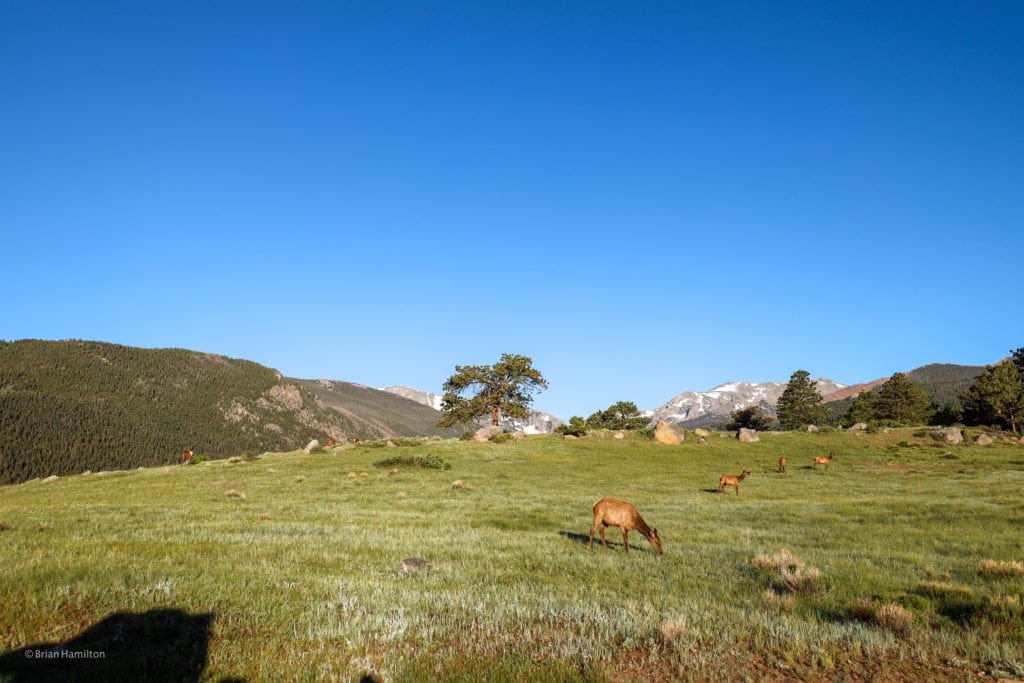
The elk herd is grazing just after sunrise in Moraine Park in Rocky Mountain National Park. Photo by Brian Hamilton.
Fauna:
Similar to much of Colorado, Rocky Mountain National Park is home to a wide range of wildlife. The diverse landscape throughout the park allows for nearly 70 species of mammals to thrive. Over time populations of grizzly bears, wolves, and American bison have been extirpated, allowing for other species to thrive.
The elk is one of the most iconic animals of the park with a range of 2,000 to 3,000 inhabiting the park during the summer months. Because the population has become so extensive, boundaries have been set up in delicate wetland environments so that they are able to grow without being eaten or trampled on. Other large animals that live within the park include bighorn sheep, moose, and mule deep. Though grizzly bears are no longer found in the park, predators are still present. Common mammals include cougars, coyotes, and bobcats, as well as foxes and Canada lynx. Black bears are known to live within the park though their population is quite limited.
Places To Stay
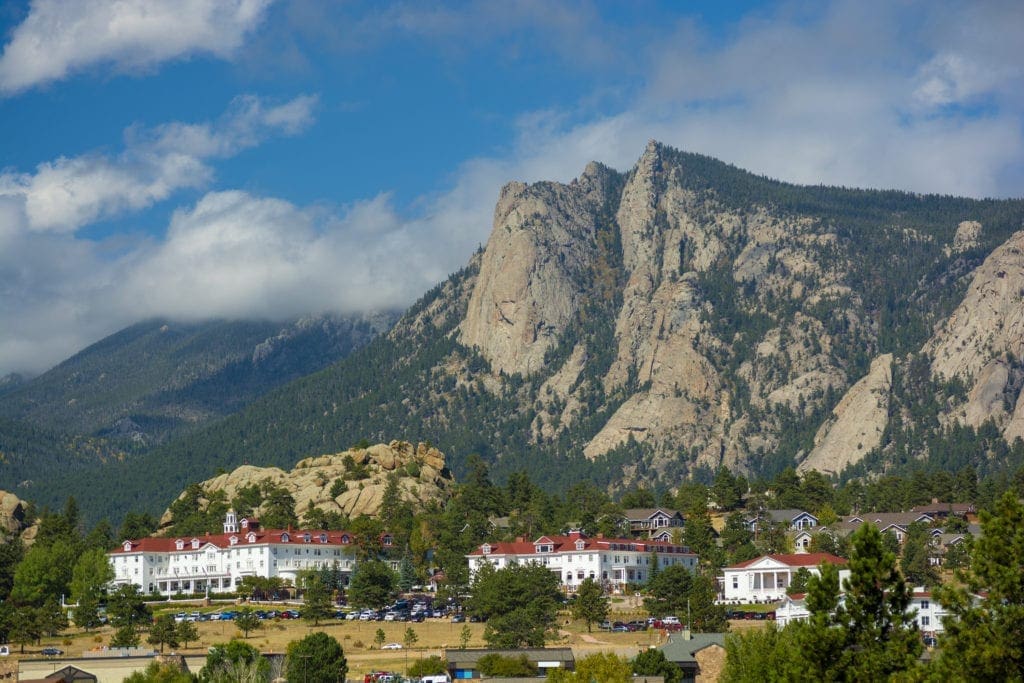
The Stanley Hotel in Estes Park, Colorado on a sunny day.
The best option for accommodations near Rocky Mountain National Park is Estes Park. The town is a four-season playground offering myriad lodging opportunities. It is impractical to stay in Grand Lake on the western side of the park because of seasonal closures along Trail Ridge.
If you’re based in the Front Range, Bear Lake is only an hour and a half from Boulder and metro Denver. Loveland, the closest major town to Estes Park, is only 45 minutes away with no traffic.
If you want to stay in Estes, please visit the tourism bureau website here. The search filters on the site will help you narrow down options. Additionally, Vrbo frequently offers great options.
Find a Hotel near Rocky Mountain National Park, Colorado.
Support Skyblue Overland by booking your hotel or cabin through one of our links.


Main Attractions:
The sheer number of mountains within the park is what draws many visitors to this portion of the Rocky Mountains. Just within the park boundaries lie over 100 peaks with elevations above 11,000 feet. The tallest point in the park is Longs Peak standing at 14,259 feet. Whether hikers choose to view it from a far, or take the longer journey up to the summit, the peak is one of the most iconic landmarks of the entire park.
While the park offers a variety of outdoor activities, Trail Ridge Road is one of the most iconic features. The road was established back in the 1930s and today is known for being the highest continuous paved highway in all of North America. Viewpoints throughout the highway allow visitors to access some of the most scenic spots, without having to explore too far.
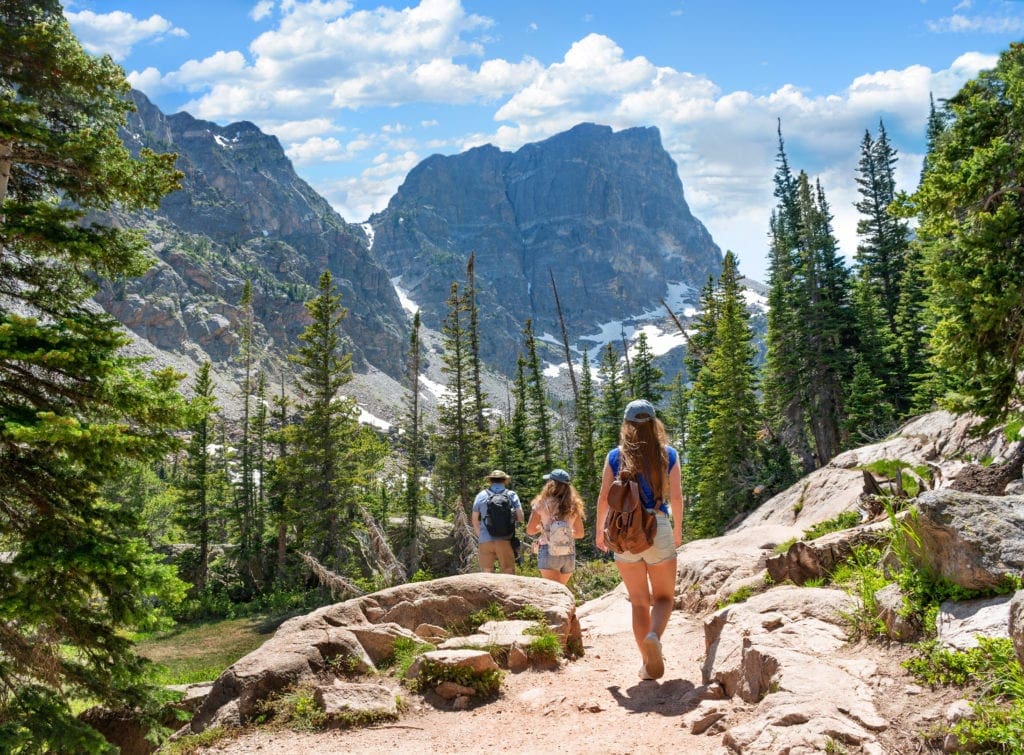
A family on summer their vacation hiking on the Emerald Lake Trail in Rocky Mountains National Park, Colorado.
Hiking
One of the best ways to experience Rocky Mountain National Park is through the extensive network of trails. Because the park receives such an immense amount of visitors, there are a wide range of hikes throughout the park, suitable for nearly every skill level. Some of the more popular beginner/intermediate hikes include Alberta Falls, Emerald Lake, and Loch Lake via Glacier Gorge Trail. For those looking for a more challenging route, popular trails include Sky Pond, Lake Haiyaha, Bear Lake or climbing to the summit of Longs Peak, the tallest point in the entire park. Hikers who wish to reach the summit of Longs Peak should study the route accordingly as there are some class 3 rock climbing sections on some of the routes to the summit.

Cyclist on Trail Ridge Road in Colorado’s Rocky Mountain National Park.
Biking
While Trail Ridge Road offers a scenic drive for many, biking the route can be even more beautiful. From the Kawuneeche Visitor Center to the Beaver Meadows Visitor Center, cyclists can ride 48 miles with over 4,000 feet of elevation gain, all while witnessing some of the most breathtaking views within the park. From mile 16 to mile 32, the road sits above the treeline, giving way to continuous viewpoints. The road is often open from the end of May through mid-October, before shutting down for the winter. If completing the entire ride sounds too difficult, bicycle touring companies in the region will shuttle groups to the top of the pass allowing them to enjoy the long and steep descent without experiencing the grueling uphill climb.
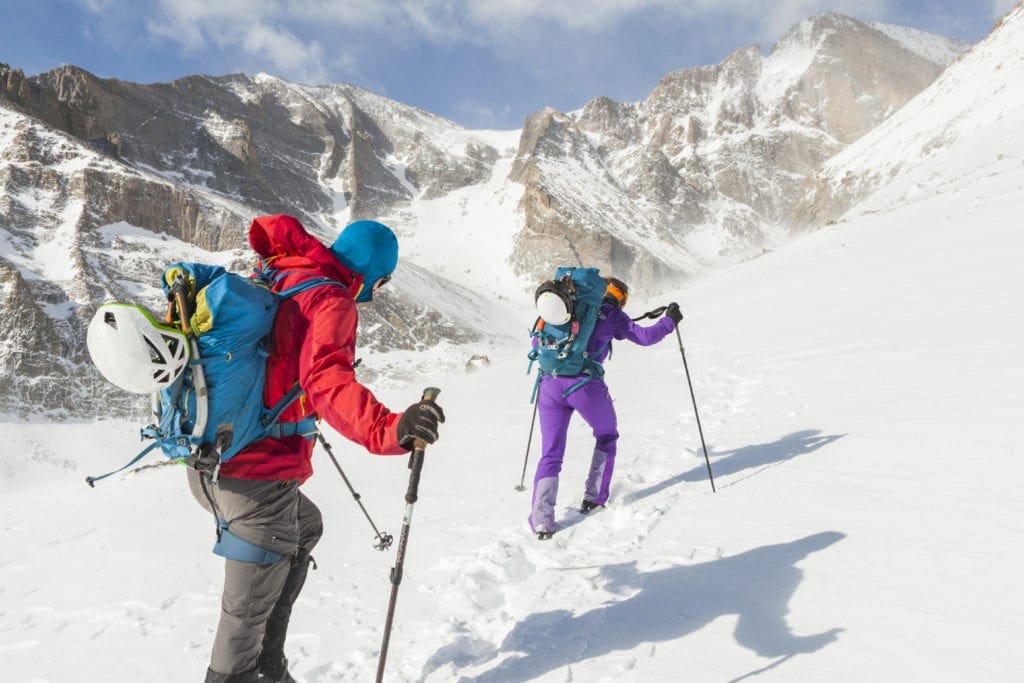
Two climbers hike towards Chasm Lake and Longs Peak in Rocky Mountain National Park, Colorado.
Book An Epic Adventure with a Guided Hike To The Top of Longs Peak in Rocky Mountain National Park, Colorado.
Climbing
Not only is Rocky Mountain National Park known for being one of the most beautiful parks in the country, but is also one of the best when it comes to rock climbing. The park boasts over 500 different routes with a large majority being classified as alpine or trad. Not only can loose rock lead to more dangerous conditions, but climbers are often completing routes above 11,000 feet. While there are routes throughout the park, many are located near Longs Peak, Glacier Gorge, Fern Canyon Rocks, and Hallett Peak.
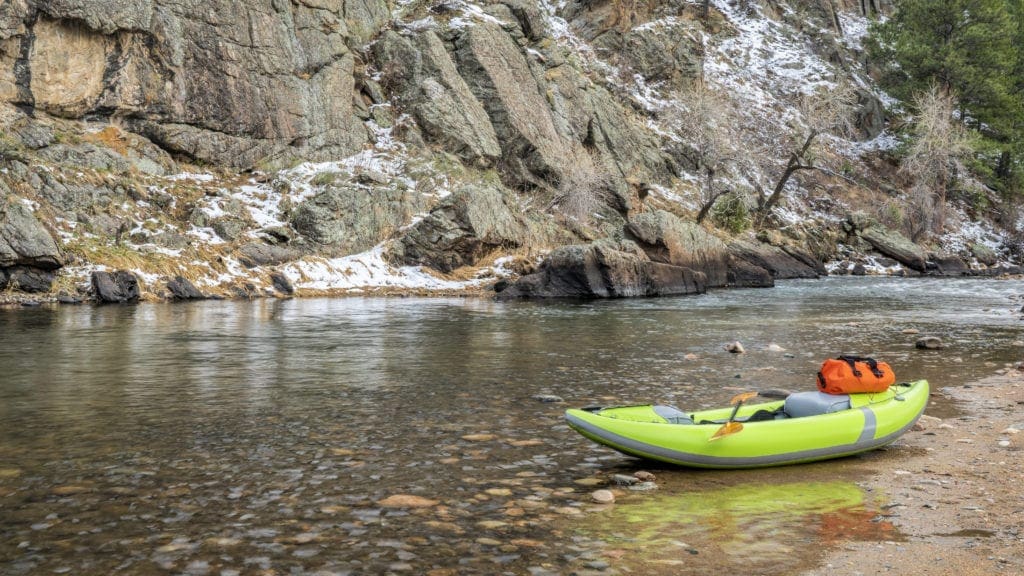
An inflatable whitewater kayak with a paddle and dry bag on a rocky shore of the Cache La Poudre river near Estes Park, Colorado.
Rafting/Kayaking
The rapids of Colorado are home to some of the best white water rafting in the entire country. Rocky Mountain Adventures is one of the primarily companies that lead trips throughout the region. The company offers beginner and advanced trips ranging from a couple hours to multi-day excursions. Trips along the Cache La Poudre lie near Estes Park and Rocky Mountain National Park. Kayaking is allowed on the lakes within the park though no motorized boats are as many of the lakes are shallow and contain delicate ecosystems.

Man snowshoeing near Emerald Lake in Rocky Mountain National Park, Colorado.
Snowshoeing
While Rocky Mountain National Park is full of activities throughout the summer months, it is also worth the visit during the winter months. Sixty three of the park’s trails are accessible for snowshoeing, ranging form a short route to a multi-hour adventure. The most popular snowshoeing trails include Emerald Lake, Sky Pond, Loch Lake, and Chasm Lake.

Skiers on Dream Lake in Colorado’s Rocky Mountain National Park.
Backcountry Skiing
Winter months mean an immense amount of snow for the Rocky Mountain National Park. Though beautiful, skiing in the backcountry should not be taken lightly and those wishing to do so should be well equipped with the proper knowledge and safety. Iconic spots for backcountry skiing include Longs Peak, Flattop, Banana Bowl, Hidden Valley, and Dragontail. Skiers will be interested in our four part series dedicated to skiing the more famous backcountry lines in Rocky Mountain National Park including Hidden Valley and Sundance Mountain Area, Bear Lake Area, Longs Peak Area and the best of the remaining ski lines. Before heading out with your skis, take a look at our guide to planning a backcountry ski adventure.

Fly fishing at Dream Lake in Rocky Mountain National Park, Colorado.
Fishing
The waters of Rocky Mountain National Park are home to four different types of trout, including brown, brook, rainbow, and cutthroat. Though there are 156 lakes in the park only 48 of them have fish, so plan accordingly before packing your fishing gear. Like all national parks in the country, Rocky Mountain National Park has strict limits for how many fish can be caught and the method of capture. There are many guided fishing trips available in Estes Park.

Horseback riding in Rocky Mountain National Park, Colorado.
Horseback riding
Horses are permitted throughout Rocky Mountain National Park. Guided horseback trips surround the region of Estes Park and heading into the national park.

The Stanley Hotel in Estes Park, Colorado on a sunny day.
Nearby Cities
The closest city to Rocky Mountain National Park is Estes Park. The city sits at an elevation of 7,522 feet and is a hub for outdoor recreation. Though the population is only around 6,500, the streets are booming throughout the year with avid hikers, bikers, and adventure seekers. Besides having places to stay and being the headquarters for Rocky Mountain National Park, Estes Park is full of local shops and restaurants. Major campgrounds right near the city include Estes Park Campground at Mary’s Lake, Spruce Lake RV Park, and Estes Park KOA Holiday.
Conclusion
Whether you’re looking for a scenic drive through the Rocky Mountains, or a long adventure to the summit of Longs Peak, Rocky Mountain National Park is the perfect place to plan a visit. With year round adventure, a wide range of activities, and an immense amount of wildlife, no two trips to the park are likely to be the same. The next time you head to Colorado, don’t forget to add this iconic park to your itinerary.

Skyblue Overland Strongly Recommends That You Enroll With Global Rescue Prior To Embarking On Your Next Adventure.
Purchase a Global Rescue membership for your next adventure and travel with peace of mind. Single trip, annual and family options are available.
Memberships start at $119.













